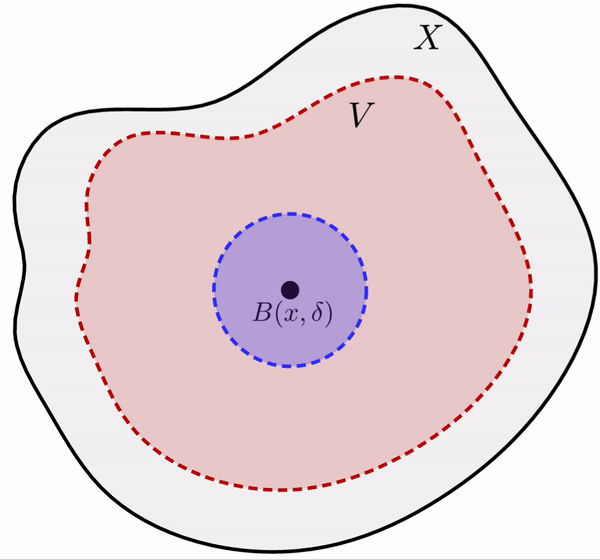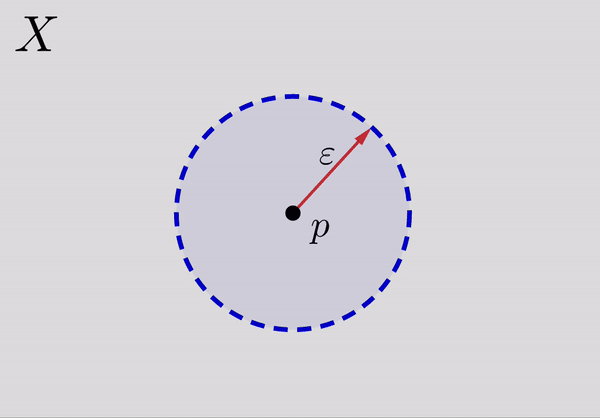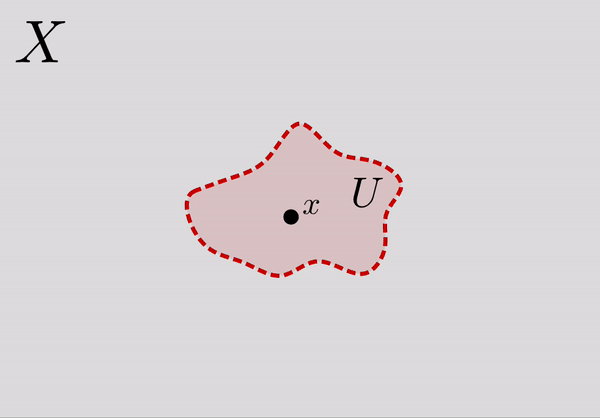Mathematical Analysis
Lecture 20
Topology
10.2 Topology
Definition 10.2.1. Let $(X,d)$ be a metric space, $x \in X$, and $\delta > 0$. Define the open ball, or simply ball, of radius $\delta$ around $x$ as \begin{equation*} B(x,\delta) := \bigl\{ y \in X : d(x,y) \lt \delta \bigr\} . \end{equation*}
10.2 Topology
|
Definition 10.2.1. Let $(X,d)$ be a metric space, $x \in X$, and $\delta > 0$. Define the open ball, or simply ball, of radius $\delta$ around $x$ as \begin{equation*} B(x,\delta) := \bigl\{ y \in X : d(x,y) \lt \delta \bigr\} . \end{equation*} |
|
10.2 Topology
|
Definition 10.2.1. Let $(X,d)$ be a metric space, $x \in X$, and $\delta > 0$. Define the open ball, or simply ball, of radius $\delta$ around $x$ as \begin{equation*} B(x,\delta) := \bigl\{ y \in X : d(x,y) \lt \delta \bigr\} . \end{equation*} Define the closed ball as \begin{equation*} C(x,\delta) := \bigl\{ y \in X : d(x,y) \leq \delta \bigr\} . \end{equation*} |
|
Example 10.2.1.
Consider the metric space $\R$ with the standard metric. For $x \in \R$ and $\delta > 0$,
$\ds B(x,\delta)$
$ =(x-\delta,x+\delta),\;$
an open interval.
$\ds C(x,\delta)$
$= [x-\delta,x+\delta],$ a closed interval.
Example 10.2.2.
Consider the metric space $\C$ with metric $d(z_1, z_2) =\abs{z_1-z_2} .$ For $z_0\in\C$ and $\delta>0$,
$\ds B(z_0,\delta)$ $ = \bigl\{ z \in \C : d( z_0, z) \lt \delta \bigr\} ,\;$
$\ds C(z_0,\delta)$ $= \bigl\{ z \in \C : d( z_0, z) \leq \delta \bigr\}.$
10.2 Topology
Definition 10.2.2.
Let $(X,d)$ be a metric space.
A subset $V \subset X$
is open
if for every $x \in V$, there exists a $\delta \gt 0$ such that
$B(x,\delta) \subset V$.
A subset $E \subset X$ is
closed if the complement $E^c = X \setminus E$ is open.
When the ambient space $X$ is not clear from context,
we say $V$ is open in $X$ and $E$ is closed in $X$.
10.2 Topology
|
Definition 10.2.2. |

Open neighborhood |
10.2 Topology
👀 Complementary reading 📖
Theorem 10.2.1. Let $(X,d)$ be a metric space.
- $\emptyset$ and $X$ are open.
- If $V_1, V_2, \ldots, V_k$ are open subsets of $X$, then $$ \ds \bigcap_{j=1}^k V_j \;\text{ is also open.} $$
- If $\{ V_\lambda \}_{\lambda \in I}$ is an arbitrary collection of open subsets of $X$, then $$\ds \bigcup_{\lambda \in I} V_\lambda \;\text{ is also open.}$$
More topological concepts
👀 Complementary reading 📖
Let $(X,d)$ be a metric space and $A \subset X$.
- Interior: $A^\circ \coloneqq \{ x \in A : \exists \delta > 0 \text{ with } B(x,\delta) \subset A \} .$
- Closure: $\overline{A} \coloneqq \bigcap \{ E \subset X : E \text{ is closed and } A \subset E \} .$
- Boundary: $\partial A \coloneqq \overline{A}\setminus A^\circ.$
More topological concepts
👀 Complementary reading 📖
- Interior: $A^\circ \coloneqq \{ x \in A : \exists \delta > 0 \text{ with } B(x,\delta) \subset A \} .$
- Closure: $\overline{A} \coloneqq \bigcap \{ E \subset X : E \text{ is closed and } A \subset E \} .$
- Boundary: $\partial A \coloneqq \overline{A}\setminus A^\circ.$
10.3 Sequences and convergence
Definition 10.3.1. A sequence in a metric space $(X,d)$ is a function $x \colon \N \to X$. As before we write $x_n$ for the $n$th element in the sequence, and for the whole sequence use the notation \begin{equation*} \{ x_n \}_{n=1}^\infty . \end{equation*}
A sequence $\{ x_n \}$ is bounded if there exists a point $p \in X$ and $B \in \R$ such that \begin{equation*} d(p,x_n) \leq B \quad \text{for all } n \in \N. \end{equation*}
10.3 Sequences and convergence
Definition 10.3.2. A sequence $\{ x_n \}$ in a metric space $(X,d)$ is said to converge to a point $p \in X$ if for every $\epsilon \gt 0$, there exists an $M \in \N$ such that $d(x_n,p) \lt \epsilon$ for all $n \geq M$. The point $p$ is said to be the limit of $\{ x_n \}$. We write \begin{equation*} \lim_{n\to \infty} x_n := p . \end{equation*}
A sequence that converges is convergent. Otherwise, the sequence is divergent.
Note: Compare this with the definition of convergence in $\R.$
10.3 Sequences and convergence
Definition 10.3.2. A sequence $\{ x_n \}$ in a metric space $(X,d)$ is said to converge to a point $p \in X$ if for every $\epsilon \gt 0$, there exists an $M \in \N$ such that $d(x_n,p) \lt \epsilon$ for all $n \geq M$. The point $p$ is said to be the limit of $\{ x_n \}$. We write \begin{equation*} \lim_{n\to \infty} x_n := p . \end{equation*}

10.3 Sequences and convergence
Theorem 10.3.1. A convergent sequence in a metric space has a unique limit.
Theorem 10.3.2. A convergent sequence in a metric space is bounded.
10.3 Sequences and convergence
Theorem 10.3.3. Let $\{ x_k \}_{k=1}^\infty$ be a sequence in $\R^n$, where we write $x_k = \bigl(x_{k,1},x_{k,2},\ldots,x_{k,n}\bigr) \in \R^n$. Then $\{ x_k \}_{k=1}^\infty$ converges if and only if $\{ x_{k,i} \}_{i=1}^\infty$ converges for every $i=1,2,\ldots,n$, in which case \begin{equation*} \lim_{k\to\infty} x_k = \Bigl( \lim_{k\to\infty} x_{k,1}, \lim_{k\to\infty} x_{k,2}, \ldots, \lim_{k\to\infty} x_{k,n} \Bigr) . \end{equation*}
10.3 Sequences and convergence
Theorem 10.3.4. Let $(X,d)$ be a metric space and $\{x_n\}$ a sequence in $X$. Then $\{ x_n \}$ converges to $x \in X$ if and only if for every open neighborhood $U$ of $x$, there exists an $M \in \N$ such that for all $n \geq M$, we have $x_n \in U$.
10.3 Sequences and convergence
Theorem 10.3.4. Let $(X,d)$ be a metric space and $\{x_n\}$ a sequence in $X$. Then $\{ x_n \}$ converges to $x \in X$ if and only if for every open neighborhood $U$ of $x$, there exists an $M \in \N$ such that for all $n \geq M$, we have $x_n \in U$.

10.3 Sequences and convergence
Theorem 10.3.5 Let $(X,d)$ be a metric space, $E \subset X$ a closed set, and $\{ x_n \}$ a sequence in $E$ that converges to some $p \in X$. Then $p \in E$.
10.4 Continuity
in metric spaces
Definition 10.4.1. Let $(X,d_X)$ and $(Y,d_Y)$ be metric spaces and $c \in X$. Then $f \colon X \to Y$ is continuous at $c$ if for every $\epsilon \gt 0$ there is a $\delta \gt 0$ such that whenever $x \in X$ and $d_X(x,c) \lt \delta$, then $d_Y\bigl(f(x),f(c)\bigr) \lt \epsilon$.
When $f \colon X \to Y$ is continuous at all $c \in X$, then we simply say that $f$ is a continuous function.
Note: Compare this with the definition of continuity in $\R.$
Continuity in metric spaces
$f \colon X \to Y$ is
continuous at $c$
if for every $\epsilon \gt 0$
there is a $\delta \gt 0$ such that
whenever $x \in X$ and $d_X(x,c) \lt
\delta$, then
$d_Y\bigl(f(x),f(c)\bigr) \lt \epsilon$.
Continuity in $\R$
$f$ is continuous at $c$
if for every $\epsilon \gt 0$
there is a $\delta \gt 0$ such that
whenever $x \in S$ and $\abs{x-c} \lt
\delta$, then
$\abs{\,f(x)-f(c)} \lt \epsilon$.
10.4 Continuity
in metric spaces and sequences
Theorem 10.4.1. Let $(X,d_X)$ and $(Y,d_Y)$ be metric spaces. Then $f \colon X \to Y$ is continuous at $c \in X$ if and only if for every sequence $\{ x_n \}$ in $X$ converging to $c,$ the sequence $\bigl\{ f(x_n) \bigr\}$ converges to $f(c).$
Note: Compare this Theorem with its version in $\R.$
10.4 Continuity
with Topology
Lemma 10.4.2. Let $(X,d_X)$ and $(Y,d_Y)$ be metric spaces. A function $f \colon X \to Y$ is continuous at $c \in X$ if and only if for every open neighborhood $U$ of $f(c)$ in $Y$, the set $f^{-1}(U)$ contains an open neighborhood of $c$ in $X$.
10.4 Continuity
with Topology
For every neighborhood $U$ of $f(c)$, the set $f^{-1}(U)$ contains an open neighborhood $W$ of $c$.
Proof of Lemma 10.4.2
$\nec$ Suppose that $f$ is continuous at $c.$ Let $U$ be an open neighborhood of $f(c)$ in $Y,$ then $B_Y\bigl(f(c),\epsilon\bigr) \subset U$ for some $\epsilon \gt 0$. By continuity of $f$, there exists a $\delta > 0$ such that whenever $x$ is such that $d_X(x,c) \lt \delta,$ implies $d_Y\bigl(f(x),f(c)\bigr) \lt \epsilon.$
Thus $B_X(c,\delta) $ $ \subset f^{-1}\bigl(B_Y\bigl(f(c),\epsilon\bigr)\bigr)$ $ \subset f^{-1}(U) ,$
and $B_X(c,\delta)$ is an open neighborhood of $c$.
Proof of Lemma 10.4.2
$\suf$ Now, let $\epsilon > 0$ be given. If $f^{-1}\bigl(B_Y\bigl(f(c),\epsilon\bigr)\bigr)$ contains an open neighborhood $W$ of $c,$ it contains a ball. That is, there is some $\delta > 0$ such that
$B_X(c,\delta) $ $ \subset W $ $ \subset f^{-1}\bigl(B_Y\bigl(f(c),\epsilon\bigr)\bigr) . $
This means that if $d_X(x,c) \lt \delta,$ then $d_Y\bigl(f(x),f(c)\bigr) \lt \epsilon.$ Therefore $f$ is continuous at $c.\;\bs $
10.4 Continuity
with Topology
Theorem 10.4.3. Let $(X,d_X)$ and $(Y,d_Y)$ be metric spaces. A function $f \colon X \to Y$ is continuous if and only if for every open $U \subset Y,$ $f^{-1}(U)$ is open in $X.$
The Essence of Topology

Source: A coffee cup and a doughnut by jcponce
Geometric properties of subsets of metric spaces
will be preserved when
continuous transformations (functions or mappings)
are applied.
☕ = 🍩